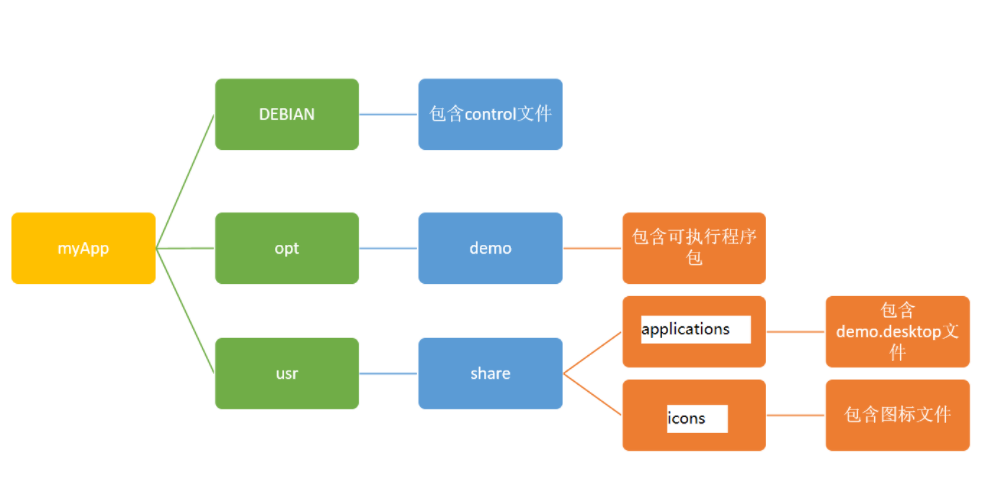关于dpkg打包成deb格式的安装包
deb格式适用于Ubuntu、deepin、UOS等操作系统,适用于各种架构mips64el,amd64、X86等架构的服务器。
Ubuntu用dpkg将qt可执行程序制作成deb安装包
一、用linuxdeployqt工具打包可执行程序
此步骤可将可执行程序依赖的动态库等打包,过程点击此处查看。
二、dpkg打包前的准备
用dpkg打包前需要“映射”的把你要在目的计算机上安装的东西放在一个目录树结构中。
首先建立一个文件夹myApp(可自定义),如你想把程序安装在opt目录下的demo文件夹内(可自定义安装路径),就在myApp内建立一个文件夹opt文件夹,在opt下建立demo文件夹,再把第一步打包好的所有文件拷贝到demo内。
需要完整建立如下的目录树结构:

说明:
control文件在dpkg打包时需要。desktop文件会出现在系统的菜单中,方便启动程序 。
control文件的内容如下:
参考官方文献
desktop文件的内容如下(可在applications目录下打开已安装程序的desktop文件做参考):
注意:在实际的文件中记得将#注释的内容都要删除。
三、dpkg命令制作deb包
在myApp的同级目录下,运行如下命令:
sudo dpkg -b myApp myApp_1.0.0_amd64.deb
打包完成即生成了myApp_1.0.0_amd64.deb 的deb包
四、dpkg的其他使用方法
安装:
sudo dpkg -i myApp_1.0.0_amd64.deb
卸载:
sudo dpkg -r myApp
查看软件信息:
sudo dpkg -l myApp
查看安装位置:
sudo dpkg -L myApp
官方参考
__EOF__
本文链接:https://www.cnblogs.com/zhuhuibiao/p/16902134.html
关于博主:评论和私信会在第一时间回复。或者直接私信我。
版权声明:本博客所有文章除特别声明外,均采用 BY-NC-SA 许可协议。转载请注明出处!
声援博主:如果您觉得文章对您有帮助,可以点击文章右下角【推荐】一下。您的鼓励是博主的最大动力!
本文来自博客园,作者:后山人,转载请注明原文链接:https://www.cnblogs.com/zhuhuibiao/p/16902134.html
经营好自己的现在,等待未来向我飞奔而来。


【推荐】国内首个AI IDE,深度理解中文开发场景,立即下载体验Trae
【推荐】编程新体验,更懂你的AI,立即体验豆包MarsCode编程助手
【推荐】抖音旗下AI助手豆包,你的智能百科全书,全免费不限次数
【推荐】轻量又高性能的 SSH 工具 IShell:AI 加持,快人一步
· TypeScript + Deepseek 打造卜卦网站:技术与玄学的结合
· Manus的开源复刻OpenManus初探
· AI 智能体引爆开源社区「GitHub 热点速览」
· 三行代码完成国际化适配,妙~啊~
· .NET Core 中如何实现缓存的预热?